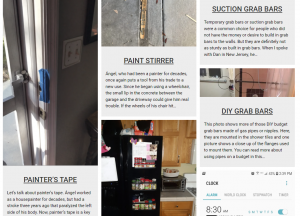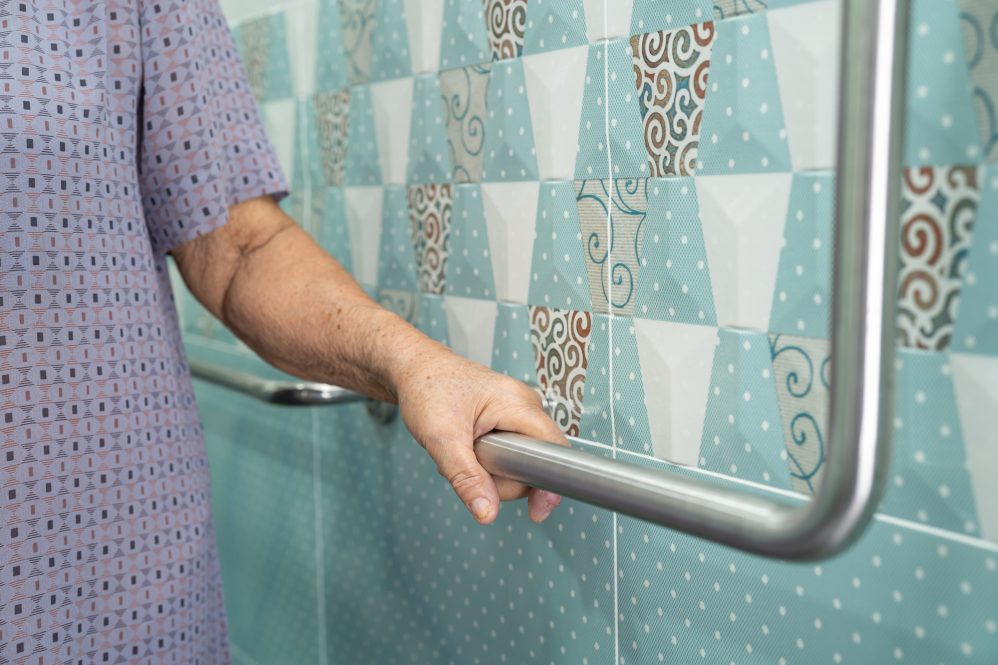Laura Mauldin could almost write a book just on the uses for painter’s tape.
“Painter’s tape is so wonderful because it doesn’t leave residue and it’s easily removed and re-stuck,” she says. “When you only have the use of one hand, you can use painter’s tape to tape down a piece of paper to sign it, or tape something to the wall so you can attach it.”
The many uses of that traditionally blue roll are just some of the little life hacks on Mauldin’s new website, Disability at Home, which, even though an offshoot of larger research, is nonetheless just as much a passion project.
Mauldin, an associate professor in Women’s, Gender, and Sexuality Studies and the human development and family sciences department, says she’s also struck by the uses for rubberized shelf liner on things like trays and by the uses for zip ties to fix things like a brake on a wheelchair.

“My work is very much about positioning disability as something that’s generative, about knowledge sharing, and about community,” she says. “All of my work counters this deficit model of disability and seeks to change the conversation to how disabled people are creators. When we start to ask different questions and look at disability in a different way then we can see the creativity and agency that disabled people have in their worlds and this website is a good way of documenting both disabled people and caregivers’ strategies.”
The effort started before the pandemic with plans for a book project funded with a UConn Humanities Institute Faculty Fellowship that would have brought her into 44 area homes to learn about the experiences of spousal caregivers in the U.S. Then came the lockdown of 2020.
To save the project, she changed the scope to allow for remote interviews, which had the upside of giving her access to spousal caregivers around the country rather than just locally. Even with these virtual interviews, she says, she still felt like she needed to see people’s surroundings to write about them.
“Part of doing ethnographic research and part of interviewing people is getting to know their world and going to them and seeing the environment that they live in and how they interact with it. That all helps you tell the story,” she explains, so she asked for pictures of various things that make life easier – think tips and tricks – and a second interview during which she could review the pictures and talk about them.
The response was overwhelming with 500 submissions documenting what people were doing in their homes with grab bars, pill cases, baby monitors, magnetic refrigerator shelves, a mortar and pestle, walkie talkies, and label makers – even paint stirrers. (Tip: Use them to level an uneven surface, like the lip between the garage and driveway, for better wheelchair access.)
Once COVID abated a year later, she was able to visit a handful of homes herself and take a few more pictures.
“That’s when I thought that all this information would be useful to the world,” she says.
A grant from UConn’s Scholarship and Collaboration in Humanities and Arts Research Program paid for a web designer and an undergraduate student to work with Mauldin to bring life to the site, which has had around 13,000 hits since going live last month.
“It really was a wonderful thing to be able to talk to people across the country and learn that they’re also doing the things they have to do to get through,” Mauldin says.
She uses the word “also” because this is a personal project for her:
“I was a caregiver to my late partner for about five years. She died in 2010 and between 2006 and 2010 she had cancer and the treatments and the disease left her with various disabilities and impairments that we were always contending with. But sometimes, we wanted to live a life of relative normalcy. We took a trip once and we had to bring her medication infusions.
“We were in a hotel, and we didn’t bring the IV pole that we had at home. We looked around and we pulled the shoelace out of her sneakers and ran the shoelace through the hole at the top of the saline bag that was typically reserved for the IV pole and tied it onto a shower curtain rod and just hung out in the bathroom while she had her infusion.

“That was a moment for me. At the time we were just doing what we had to do, and I didn’t think of it until much later, maybe even during this project, that we had our own coping tricks that we rigged up. That experience was the impetus for doing the project from the start because, I thought, I have this experience but I’m certainly not alone, and, in fact, there are millions of people who have gone through that or are currently going through that. This project was about documenting what they’re doing.”
Out of that, first came the book project and later the at-home website. In between she earned funding from the Social Science Research Council Rapid Response Grants to Covid-19 and the Social Sciences because she added in a section on caregiving struggles during the pandemic to the 44 personal interviews conducted for the book. The results will appear in a paper that will come out later.
“With all the stigma around disability, it can be hard to know how to ask, or know that you can ask, or know there is knowledge out there,” Mauldin says. “If we only think of disabilities as this tragedy, we don’t also recognize that this is part of being a human being and this is part of how we make our world.”
Mauldin says the website is for anyone who needs to modify their home or surroundings, whether because of impairments caused by a disease or surgery, an accident or natural aging, unexpected affliction or birth defect. She’s also eager to receive submissions of other solutions via the website’s contact page.
“There’s a real hesitancy to talk about disability,” Mauldin says. “For me, that’s the other purpose of the site, to talk about disability in a casual, plain way. We don’t need to romanticize it. We don’t need to demonize it. We can just talk about it as a fact of life. Let’s all talk about this because we all deal with it in some way or another.”
Visit the Disability at Home website at disabilityathome.org.



